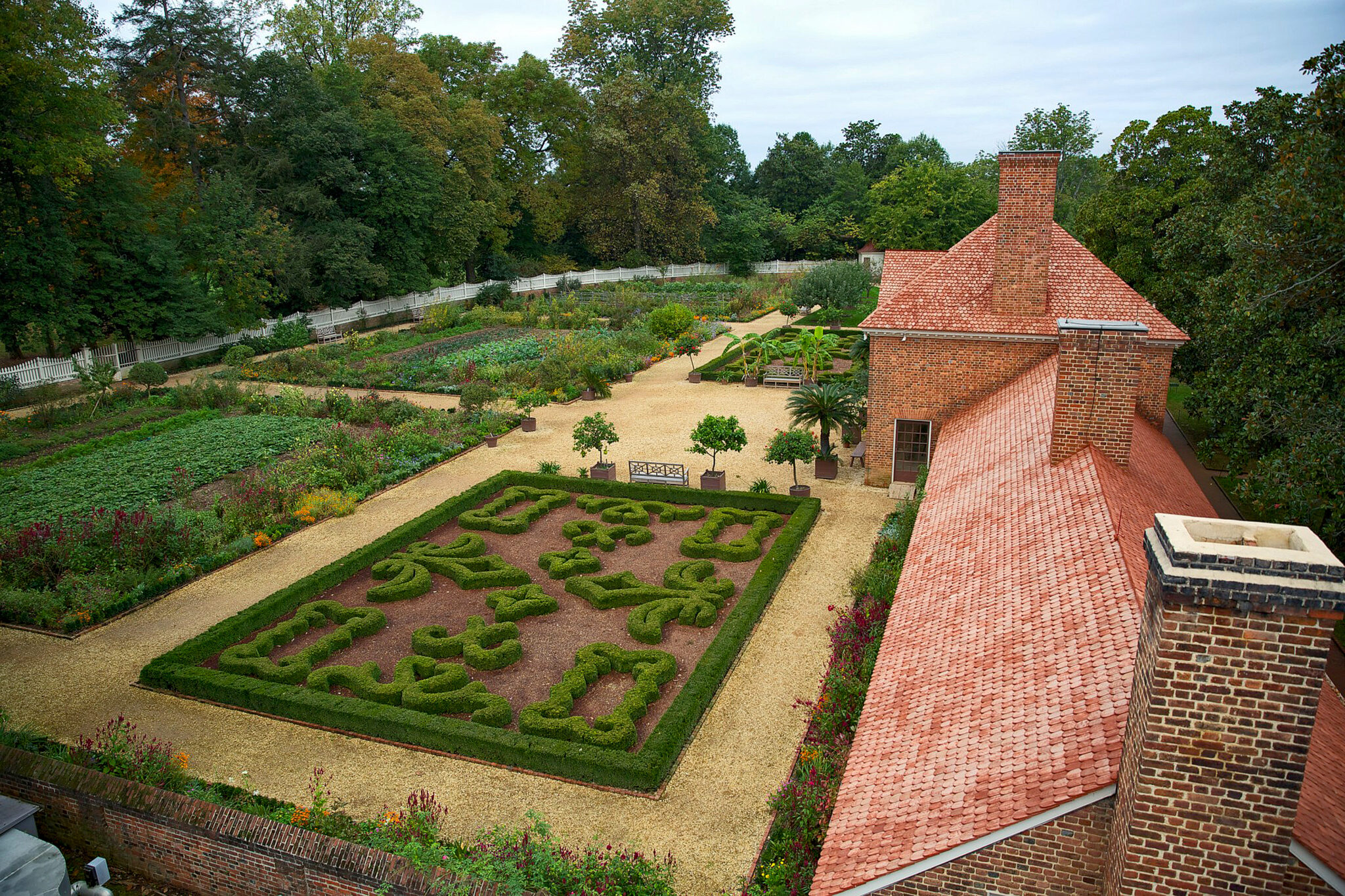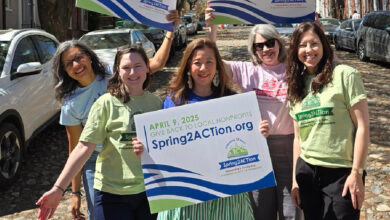Dean Norton Has Walked Mount Vernon’s Grounds Longer Than the General Himself!
As Horticulture Director, Norton has guided the estate’s gardens for 55 years.

Alexandria, VA – Like millions of other gardeners and horticulturists across America, Dean Norton is seeing the promise of green things to come this spring: The soil is rich, dark, and turned, the seed stock germinates silently in the greenhouse, and the excitement of reawakening nature is palpable.
Standing on a hill overlooking the Potomac River at one of the best-known historic farms in the world, Norton, the horticulture director of the Mount Vernon Estate, gazed across acres of composted ground where annuals like snowdrops and crocus already appear. Hinting at the return of spring also are slender, spring-green stems of early daffodil and tulip leaves in the Upper and Lower Gardens, even though it’s still six weeks ahead of actual planting dates.
The verdant hues of spinach, kale, globe artichokes, and rosemary indicate that the early arrival of spring 2024 is progressing. Less than 48 hours after a recent snowmelt in Northern Virginia, Norton inspected the estate’s grounds as he has for nearly the last 55 years (longer than the future First President of America himself walked the grounds), plucked a couple of fresh spinach leaves, and popped one into his mouth with a smile of satisfaction that all is going to plan.


Dean Norton is a trained historical horticulturist who grew up no more than five miles from the estate and worked at Mount Vernon before, during, and after earning his degree in Horticulture from Clemson University. He has studied primary source documentation of Mount Vernon gardens with his wife Susanne, who started as an intern here while attending Virginia Tech.
Norton credits Washington’s ingenious use of constructing the “microclimate” of the garden tracts—tall brick border walls, composted leveled terraces, and unobstructed sun exposure designed by George Washington himself—as the reason these gardens continued to flourish earlier than the average of Northern Virginia.
Norton pointed out a pretty corner of the Lower Garden, noting the tiny gardener’s tower in the corner where he proposed to Susanne. (The couple now has four grown daughters.) Virtually Norton’s entire life from the age of 16 to today (his 55th work anniversary date is June 23, 2024) has been dedicated to continuing the traditions of the estate, from heirloom seeds and generations of shrubs and trees to its flourishing livestock living and working the Mount Vernon farm.
During his lifetime, George Washington enjoyed agricultural experimenting, especially in a small garden called “The Little Garden.” He monitored new methods and plants he collected from his reading and travels there. Washington built the still-existing greenhouse just west of the mansion to enjoy tropical fruits and to extend the growing seasons. His walled gardens—with red brick walls up to seven feet high—created microclimates, which Norton esteems, resulting in better protection from wind and wildlife for the young buds and blossoms, thereby increasing the gardens’ production.



As spring approaches, garden seedlings, including small sprigs of cabbage and cauliflower, are itching to escape the mansion’s greenhouses. In early March, those plants will join the estate’s vegetable, fruit, and flower gardens, heavily toured by tourists throughout all seasons. Mount Vernon remains a fully functioning historic property open throughout the year.
The mansion’s four gardens—all maintained with adherence to Washington’s 18th-century garden masterplans—reflect untold hours of toil by the seven full-time gardeners and landscapers, two greenhouse staff, five full-time livestock caretakers, and additional seasonal help. The four gardens comprise the Upper Garden (next to the historic greenhouse illuminated by three-story colonial windows), the Lower Garden (commonly known as Martha’s Garden), “The Little Garden,” and the 4-acre Fruit Orchard.
The four gardens, totaling approximately seven acres, supplied all the food for the Washington family, other residents, and guests to Mount Vernon in the day. Besides the high walls protecting plants from storms and maintaining warmth inside the walled garden, Washington surrounded his vegetables and berry varieties with a wealth of flowers and fruit trees, attracting beneficial insects and the admiration of his guests.
Washington’s estate drawings show guests entering from a road with still-surviving stone pillars at the southern end of the estate and proceeding to the front lawn, known as the bowling green, and present a full exposition of the three largest garden tracts filled with flowers, shrubs, trees, and vegetables. (The first president’s early efforts and experimentation with a vineyard were not as successful as expected, so Washington replaced them with native fruit trees, according to Norton). No doubt, guests arrived with appetites—as they still do under the shade of the same historic assortment of magnolia, holly, and weeping willow trees and sculpted boxwoods.


“Our staff and our greenhouses supply the historic gardens with the annuals, herbs, and other specific plants and trees we wouldn’t be able to find elsewhere,” said Norton as he removed some dried flower heads from one of the refrigerated trays that preserve the seeds for spring planting and crushed open a pod to reveal several minuscule seeds.
“Heirloom plants typically are stronger plants…they’re just tough, and the product is good tasting,” he said, noting that plant trends are not part of the picture at the estate. “Our thing is not fun or tasty…but historical accuracy.”
Norton noted that the decisions on what to plant and where are part of his horticultural decision-making. He added that his responsibility is to maintain the authentic and historical plans for each of the four gardens while managing each garden’s soil nutrients. Hybrids were never an option at Mount Vernon. The choices of what to plant and where are strictly curtailed by the owner of the grounds: the Mount Vernon Estate.
Somewhat ironically, Norton finds one of the most exciting aspects of his life over the last 50-plus years as Mount Vernon’s head horticulturist and director of five related divisions is the goal to maintain consistency and historical accuracy. When it comes to gardening choices, Norton’s selections were already made by Washington’s impeccable letters, diaries, and ledgers.

An overwhelming majority of the heirloom seeds claim a heritage at the farm that goes back more than decades. No one doubts Norton when he claims the lineage of some plant varieties can be traced back centuries at Mount Vernon. He can also recall what plants over the last five decades of summers at Mount Vernon have been rotated from one garden area to another to achieve the best soil regeneration.
The livestock on the working farm contributes to the enriched compost year after year, as the historical record found in journals, diaries, letters, and other communications displayed in the halls of the Mount Vernon Museum shows they did when then-master gardener George Washington worked this farm, long before he became the First President of the United States.
Dean Norton remains enthralled by the health and heritage of the four authentically located and operating gardens his long-ago predecessor, George Washington, cultivated. In 1858, the Mount Vernon Ladies Association purchased approximately 200 acres of the 400-acre tract it now operates. Today, Norton said he is the longest current employee on the estate and functions as a walking and talking archivist. In addition to his Mount Vernon post, Norton also holds a commission to the Committee for the Preservation of the White House, which includes that estate’s gardens and extended grounds.
“I work for the first president and I consult for the current president,” said Norton, stressing first and current as his tenure has offered him an ironic twist of fact and history. Quoting one of Washington’s gardeners about his lifetime of work in the estate’s gardens, Norton added, “I’ve never been happier in my life.”
ICYMI: Aspen on the Avenue Shusses to the Slopes in Del Ray!




